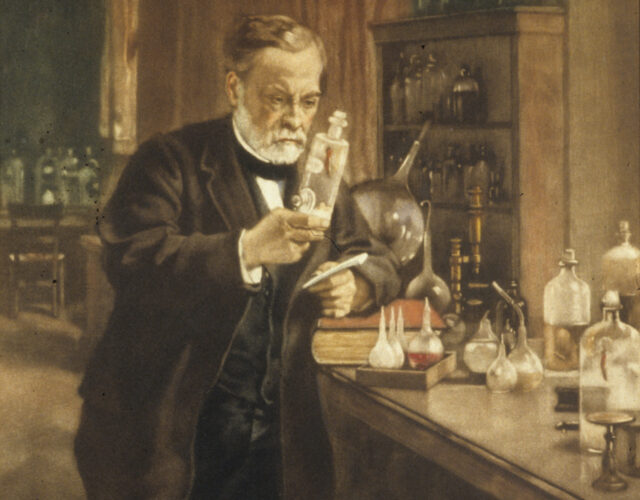In October 1831 an eight-year-old boy in a French town witnessed the aftereffects of an attack by a rabid wolf on his fellow townspeople, some of whom submitted themselves to the then-traditional treatment for rabies—cauterization with a burning-hot iron. Louis Pasteur, the young boy, heard the agonized screams.
Viper’s venom, crayfish eyes, and the liver of a mad dog—these were some of the treatments forced on rabies sufferers throughout history. Though other diseases claimed many more lives, the long and fearful wait (up to a year in humans) before the inevitably fatal symptoms might appear—the rage in animals, and the hallucinations, seizures, and intense fear of water in humans—has induced terror as far back as the days of the ancient Greeks.
In the summer of 1885 an anguished Madame Meister brought her nine-year-old son, Joseph, to the laboratory of a scientist named Louis Pasteur. With 14 cauterized dog bites on his legs and hand, the boy could barely walk. Joseph’s mother feared the worst but hoped Pasteur, already a public figure in France, could save her son. Pasteur, champion of the germ theory of disease, had identified “living germs” as the cause of anthrax and had developed a vaccine for that disease. In 1880 he began studying rabies, but by 1885 his rabies vaccine had not been fully tested, even in animals. Although certainty of infection could be established only when symptoms appeared, Pasteur believed that because of the number of bites on Joseph’s body, death was almost certain.
With seemingly little to lose, Pasteur injected Joseph daily with a series of progressively less desiccated spinal cords taken from rabies-infected rabbits—moving from most dry and least virulent cords to freshest and most virulent. Joseph never developed symptoms, and Pasteur became an international hero.
The vicious disease had met its match. From as far away as Russia and the United States people made their way to Pasteur’s laboratory for treatment. The success of the rabies vaccine and Pasteur’s chemical approach gave a powerful boost to the new experimental medicine and highlighted the growing power of scientists in the lab versus that of doctors at the bedside.
Treatment methods today remain broadly similar to those of Pasteur’s. After a bite by a suspected rabid animal, doctors inject a dose of rabies immune globulin, a human antibody against the rabies virus that provides a short-term boost to the immune system. A second injection contains the rabies virus vaccine. This two-pronged approach takes advantage of the virus’s unusually long incubation period to develop the patient’s immune response. Scientists have also developed pre-exposure vaccines for humans likely to be exposed to rabies—such as veterinarians and wildlife biologists—and vaccines for some animals.
The virus has been completely eliminated in many countries 125 years after Pasteur’s treatment of Joseph Meister, while post-bite treatment has a success rate near 100%. Yet 55,000 people die of rabies each year, mostly children living in Africa or Asia. While the rabies vaccine is highly effective, it isn’t cheap enough for widespread use in countries where rabies kills the most people.
World Rabies Day is dedicated to stopping human rabies deaths by increasing worldwide access to treatment and by preventing rabies in animals. The fourth annual celebration of World Rabies Day occurs on 28 September this year. Partnering with the World Rabies Day initiative is the Institut Pasteur, today an international leader in the fight against infectious diseases. Founded in Paris by Pasteur in 1887 to provide rabies treatment, the Institut owes its establishment to a worldwide outpouring of donations, including one in the name of Joseph Meister.




